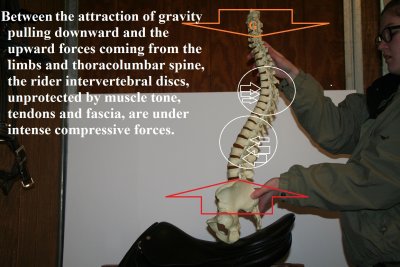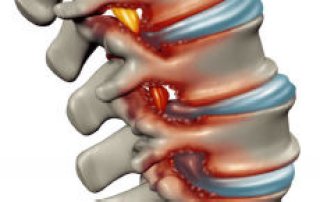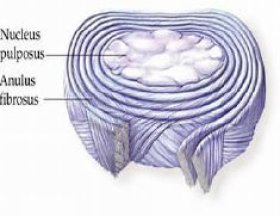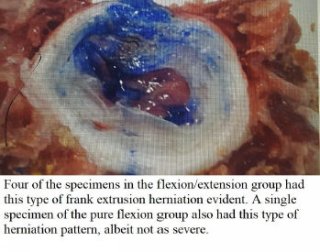Low Back Pain
Low Back Pain
Jean Luc Cornille
Under compressive load, repetitive flexion to extension of the spinal column places the vertebral column at risk of intervertebral disc herniation. On the horse, the rider's vertebral column is under compressive load and submitted to a cyclic repetition of flexion to extension. This might explain why so many riders suffer from low back pain.


Schools of thought encouraging the rider to follow the horse's movement through greater flexion to extension of the vertebral column may very well place the rider's spine at risk of nucleus migration through breaches in delaminated annulus collagen (Tampier et al,. 2007)

The terminology is complex but the pictures are clear.
The annulus fibrosus is the tough circular exterior of the intervertebral disc that surrounds the soft inner core, the nucleus pulposus.
The nucleus pulposus of the disc acts as a shock absorber, absorbing the impact of the body's activities and keeping the two vertebrae separated.
When the spine is in flexion, researches have demonstrated that the nucleus pulposus infiltrated the annulus posteriorly. Conversely, the pulposus nucleus migrates anteriorly when the spine is in extension. As a result of previous researches, it was believed that extension of the spine could reverse the posterior herniation created by the flexion.
In 2012, Christian Balkovec and Stuart McGill demonstrated that spinal motion segments exposed to both flexion and extension showed significantly more annular damage and axial creep compared to those exposed to flexion alone. "The higher amount of axial creep found in the flexion and extension group may be attributed o the higher range of motion, and the larger amount of stress placed on the segment in extension." (Christian Balkovec, Stuart McGil, Extent of nucleus migration in the annulus of porcine intervertebral discs exposed to cyclic flexion only versus cyclic flexion and extension. Clinical biomechanics 27 (2012) 766-770)
Attempting to break a wire might help one to understand the phenomenon. A wire will break faster if it is cyclically bent in both directions creating larger stress-strain reversals as opposed to only one. The sad aspect is that many riders suffer low back pain for life because the riding techniques have, under the name of tradition, elected to perpetuate a heresy instead of evolving with knowledge. The concept of following the horse's back relaxing the rider's back, has been repetitively contradicted by the evolution of knowledge starting in 1964 with Richard Tucker's first biomechanics analysis of the equine back. In 1975. Hans Carlson demonstrated that the primary function of the back muscles was resisting motion, preventing the thoracolumbar spine form a range of motion that the thoracolumbar column could not assume. In 1980, Leo Jeffcott measured the possible range of motion of the equine thoracolumbar spine, finding that it was limited in the dorsoventral direction to 53,1mm, which is less than two inches and a quarter.
On the saddle, the rider is submitted to the sum of forces and movements created by the limited motion of the thoracolumbar spine and the large amount of movement and forces produced by the hind and front legs. Advising the rider to relax one's vertebral column in order to follow the sum of the horse's limbs and thoracolumbar spine movement is a heresy crippling both, the rider and the horse.
There is a reason for the elastic stiffness diversity of the muscles. The muscles absorb forces while protecting the integrity of the structures. It is interesting that the neutral seat taught by the science of motion and originally designed to protect the horse's thoracolumbar spine from excessive movements of the rider vertebral column, also protects the rider's vertebral column form herniation and low back pain. Muscles allow the rider to reduce the forces induce in his or her vertebral column by the sum of the horse's limbs action and thoracolumbar spine movements and limit the range of motion of his or her vertebral column to the range of motion of the horse's thoracolumbar spine.
Tracking the nucleus as it migrates through the annulus required to use a visual method. Balkovec and McGill used a radio-opaque blue dye mixture allowing spectacular and alarming pictures.


Every specimen in the flexion/extension group had evidence of nucleus tracking through the posterior annulus. Maybe, watching the damages occurring within one's intervertebral discs following the concepts of relaxation and swinging motion promoted by conventional equitation, might encourages one to critically question traditional equitation and explore the principles of the neutral seat.
Very likely, the reason why many riders develop low back pain is that their equitation is based on large flexion and extension of their vertebral column. Very likely, the reason why many horses develop thoracolumbar dysfunction and consequent limbs kinematics abnormalities and injuries, is that their rider's equitation is based on archaic theories.
Jean Luc Cornille


 twitter
twitter facebook
facebook google
google pinterest
pinterest linkedin
linkedin